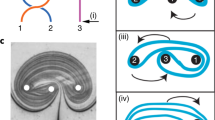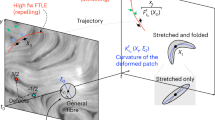Abstract
The study of liquid crystals at equilibrium has led to fundamental insights into the nature of ordered materials, as well as to practical applications such as display technologies. Active nematics are a fundamentally different class of liquid crystals, driven away from equilibrium by the autonomous motion of their constituent rod-like particles1,2,3,4. This internally generated activity powers the continuous creation and annihilation of topological defects, which leads to complex streaming flows whose chaotic dynamics seem to destroy long-range order5,6,7,8,9,10,11. Here, we study these dynamics in experimental and computational realizations of active nematics. By tracking thousands of defects over centimetre-scale distances in microtubule-based active nematics, we identify a non-equilibrium phase characterized by a system-spanning orientational order of defects. This emergent order persists over hours despite defect lifetimes of only seconds. Similar dynamical structures are observed in coarse-grained simulations, suggesting that defect-ordered phases are a generic feature of active nematics.
This is a preview of subscription content, access via your institution
Access options
Subscribe to this journal
Receive 12 print issues and online access
$259.00 per year
only $21.58 per issue
Buy this article
- Purchase on Springer Link
- Instant access to full article PDF
Prices may be subject to local taxes which are calculated during checkout




Similar content being viewed by others
References
Narayan, V., Ramaswamy, S. & Menon, N. Long-lived giant number fluctuations in a swarming granular nematic. Science 317, 105–108 (2007).
Duclos, G., Garcia, S., Yevick, H. G. & Silberzan, P. Perfect nematic order in confined monolayers of spindle-shaped cells. Soft Matter 10, 2346–2353 (2014).
Zhou, S., Sokolov, A., Lavrentovich, O. D. & Aranson, I. S. Living liquid crystals. Proc. Natl Acad. Sci. USA 111, 1265–1270 (2014).
Brugués, J. & Needleman, D. Physical basis of spindle self-organization. Proc. Natl Acad. Sci. USA 111, 18496–18500 (2014).
Aditi Simha, R. & Ramaswamy, S. Hydrodynamic fluctuations and instabilities in ordered suspensions of self-propelled particles. Phys. Rev. Lett. 89, 058101 (2002).
Sanchez, T., Chen, D. T. N., DeCamp, S. J., Heymann, M. & Dogic, Z. Spontaneous motion in hierarchically assembled active matter. Nature 491, 431–434 (2012).
Giomi, L., Bowick, M. J., Ma, X. & Marchetti, M. C. Defect annihilation and proliferation in active nematics. Phys. Rev. Lett. 110, 228101 (2013).
Thampi, S. P., Golestanian, R. & Yeomans, J. M. Velocity correlations in an active nematic. Phys. Rev. Lett. 111, 118101 (2013).
Thampi, S. P., Golestanian, R. & Yeomans, J. M. Instabilities and topological defects in active nematics. Europhys. Lett. 105, 18001 (2014).
Gao, T., Blackwell, R., Glaser, M. A., Betterton, M. & Shelley, M. J. Multiscale polar theory of microtubule and motor-protein assemblies. Phys. Rev. Lett. 114, 048101 (2015).
Ngo, S. et al. Large-scale chaos and fluctuations in active nematics. Phys. Rev. Lett. 113, 038302 (2014).
Chuang, I., Durrer, R., Turok, N. & Yurke, B. Cosmology in the laboratory: Defect dynamics in liquid crystals. Science 251, 1336–1342 (1991).
Nelson, D. & Halperin, B. Dislocation-mediated melting in two dimensions. Phys. Rev. B 19, 2457–2484 (1979).
Renn, S. R. & Lubensky, T. C. Abrikosov dislocation lattice in a model of the cholesteric to smectic-A transition. Phys. Rev. A 38, 2132–2147 (1988).
Brandt, E. H. The flux-line lattice in superconductors. Rep. Prog. Phys. 58, 1465–1594 (1995).
Toner, J. & Tu, Y. Long-range order in a two-dimensional dynamical XY model: How birds fly together. Phys. Rev. Lett. 75, 4326–4329 (1995).
Toner, J., Tu, Y. & Ramaswamy, S. Hydrodynamics and phases of flocks. Ann. Phys. 318, 170–244 (2005).
Vicsek, T. & Zafeiris, A. Collective motion. Phys. Rep. 517, 71–140 (2012).
Marchetti, M. C. et al. Hydrodynamics of soft active matter. Rev. Mod. Phys. 85, 1143–1189 (2013).
Palacci, J., Sacanna, S., Steinberg, A. P., Pine, D. J. & Chaikin, P. M. Living crystals of light-activated colloidal surfers. Science 339, 936–940 (2013).
Redner, G. S., Hagan, M. F. & Baskaran, A. Structure and dynamics of a phase-separating active colloidal fluid. Phys. Rev. Lett. 110, 055701 (2013).
Weber, C. a., Bock, C. & Frey, E. Defect-mediated phase transitions in active soft matter. Phys. Rev. Lett. 112, 168301 (2014).
Wensink, H. H. et al. Meso-scale turbulence in living fluids. Proc. Natl Acad. Sci. USA 109, 14308–14313 (2012).
Tjhung, E., Marenduzzo, D. & Cates, M. E. Spontaneous symmetry breaking in active droplets provides a generic route to motility. Proc. Natl Acad. Sci. USA 109, 12381–12386 (2012).
Keber, F. C. et al. Topology and dynamics of active nematic vesicles. Science 345, 1135–1139 (2014).
Nédélec, F. J., Surrey, T., Maggs, A. C. & Leibler, S. Self-organization of microtubules and motors. Nature 389, 305–308 (1997).
Needleman, D. J. et al. Synchrotron X-ray diffraction study of microtubules buckling and bundling under osmotic stress: A probe of interprotofilament interactions. Phys. Rev. Lett. 93, 198104 (2004).
Hilitski, F. et al. Measuring cohesion between macromolecular filaments one pair at a time: Depletion-induced microtubule bundling. Phys. Rev. Lett. 114, 138102 (2015).
Hentrich, C. & Surrey, T. Microtubule organization by the antagonistic mitotic motors kinesin-5 and kinesin-14. J. Cell Biol. 189, 465–480 (2010).
Shribak, M. & Oldenbourg, R. Techniques for fast and sensitive measurements of two-dimensional birefringence distributions. Appl. Opt. 42, 3009–3017 (2003).
Bates, M. A. & Frenkel, D. Phase behavior of two-dimensional hard rod fluids. J. Chem. Phys. 112, 10034 (2000).
Shi, X. Q. & Ma, Y. Q. Topological structure dynamics revealing collective evolution in active nematics. Nature Commun. 4, 3013 (2013).
Acknowledgements
The experimental portion of this study was primarily supported by the Department of Energy, Office of Basic Energy Sciences, through award DE-SC0010432TDD (S.J.D. and Z.D.). The computational portion of this work (G.S.R., M.F.H. and A.B.) was supported by NSF-MRSEC-1420382 and NSF-DMR-1149266. Computational resources were provided by the NSF through XSEDE (Stampede and Trestles) and the Brandeis HPCC, which is partially supported by the Brandeis MRSEC (NSF-MRSEC-1420382). We acknowledge the use of a MRSEC optical and biosynthesis facility supported by NSF-MRSEC-1420382.
Author information
Authors and Affiliations
Contributions
S.J.D. and Z.D. conceived the experiments and G.S.R., A.B. and M.F.H. conceived the simulations. S.J.D. acquired experimental data. G.S.R. performed computer simulations. S.J.D. and G.S.R. analysed defect dynamics. S.J.D., G.S.R., A.B., M.F.H. and Z.D. wrote the paper. All authors revised the manuscript.
Corresponding authors
Ethics declarations
Competing interests
The authors declare no competing financial interests.
Supplementary information
Supplementary Information
Supplementary Information (PDF 4130 kb)
Supplementary Information
Supplementary Movie 1 (MOV 26283 kb)
Supplementary Information
Supplementary Movie 2 (MOV 34571 kb)
Supplementary Information
Supplementary Movie 3 (MOV 11910 kb)
Supplementary Information
Supplementary Movie 4 (MOV 22171 kb)
Supplementary Information
Supplementary Movie 5 (MOV 28783 kb)
Rights and permissions
About this article
Cite this article
DeCamp, S., Redner, G., Baskaran, A. et al. Orientational order of motile defects in active nematics. Nature Mater 14, 1110–1115 (2015). https://doi.org/10.1038/nmat4387
Received:
Accepted:
Published:
Issue Date:
DOI: https://doi.org/10.1038/nmat4387
This article is cited by
-
The crucial role of adhesion in the transmigration of active droplets through interstitial orifices
Nature Communications (2023)
-
Mechanical stress driven by rigidity sensing governs epithelial stability
Nature Physics (2023)
-
Length-dependent alignment of large-area semiconducting carbon nanotubes self-assembly on a liquid-liquid interface
Nano Research (2023)
-
Competing instabilities reveal how to rationally design and control active crosslinked gels
Nature Communications (2022)
-
Tomographic measurement of dielectric tensors at optical frequency
Nature Materials (2022)



